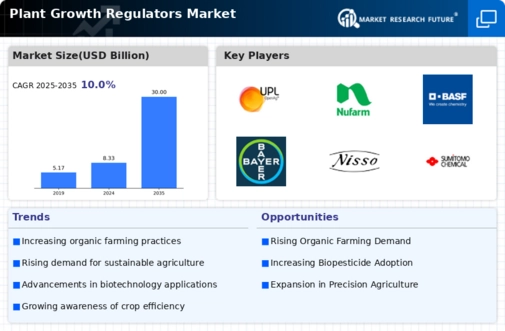Market Trends
Key Emerging Trends in the North America Plant Growth Regulators Market
Precision agriculture is gaining popularity in North America's Plant Growth Regulators (PGR) sector. Growers are adopting PGRs to boost crop yields, resource efficiency, and agricultural production via tailored growth regulator application. Plant Growth Regulators are being used more due to customer desire for organic and sustainable food. Farmers are using PGRs to promote healthy plant development, boost crop production, and manage organic and sustainable agricultural cultivation to meet the market's environmental standards. Plant Growth Regulators are enhancing crop quality and uniformity. Farmers and agricultural experts use PGRs to manage plant height, increase fruit size, and assure uniform ripening to produce high-quality crops that match market expectations. The North American PGR market is growing into horticulture, including fruits, vegetables, and ornamentals. Horticultural crops' various demands are met by PGRs, which regulate plant growth, blooming, and fruit development. PGRs to improve crop stress tolerance are becoming more popular as climate change and unpredictable weather patterns threaten agriculture. Environmental challenges including drought, severe temperatures, and soil salt are mitigated by plant growth regulators, improving crop resilience. PGR formulations are improving, including new and more effective solutions. Bioavailability, simplicity of application, and targeted distribution are improving plant growth control choices for farmers. Plant Growth Regulators are being used due to government policies promoting sustainable agriculture. Sustainable farming and lower chemical input incentives drive market growth as farmers comply. North America is combining biostimulants with plant growth regulators. Blending PGRs with biostimulants improves plant growth, nutrient absorption, and stress tolerance for holistic crop management and higher yield and quality. Turf management for lawns, sports fields, and golf courses is using North American PGR beyond agriculture. This sector is growing because PGRs manage grass growth, increase turf density, and improve landscaped areas' aesthetics. Agriculture needs sustainable water management, hence PGRs are used. Plant Growth Regulators optimize water usage efficiency, reduce irrigation, and promote crop drought resistance, supporting sustainable water management. Plant Growth Regulators are helping row crops including maize, soybeans, and cotton. PGRs help farmers grow row crops more efficiently by managing crop height, lodging resistance, and yield potential. The North American PGR market is consolidating via mergers and acquisitions, promoting important player cooperation. This movement uses collective experience, product portfolio expansion, and distribution network improvements to fulfill regional farmers' different demands.












Leave a Comment